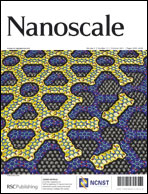In vivo upconversion luminescence (UCL) imaging, exhibiting favorable characteristics such as high photostability, no blinking, sharp emission lines, and long lifetimes, is recognized as the excellent and significant photoluminescence imaging for the future. To develop the imaging system with high visual sensitivity and tissue penetration, the functional molecules with X-ray computed tomography (CT) contrast were grafted onto upconversion nanoparticles to obtain β-NaYF4:18% Yb3+,2%Er3+@SiO2-I/PEG (UCNPs@SiO2-I/PEG) nanoprobes. These nanoprobes are water-soluble, have low cytotoxicity, and possess excellent UCL and remarkable CT contrast. Of particular note is that, besides the element iodine, rare earth elements (Y, Yb, and Er) present in the nanoprobes also show CT contrast. Moreover, no background autofluorescence signal is found in in vivoUCL images. We believe that these nanoprobes with dual modal in vivo imaging of UCL and CT can serve as a promising platform for clinical diagnosis or biomedical studies.

You have access to this article
 Please wait while we load your content...
Something went wrong. Try again?
Please wait while we load your content...
Something went wrong. Try again?


 Please wait while we load your content...
Please wait while we load your content...